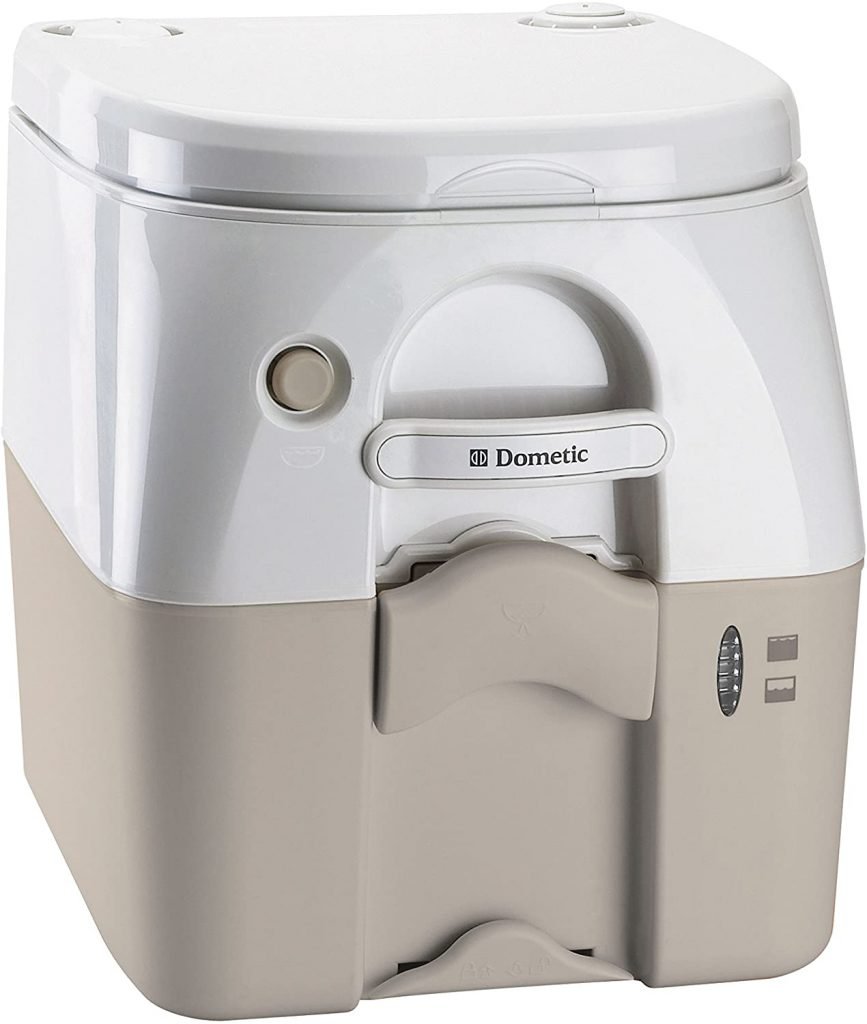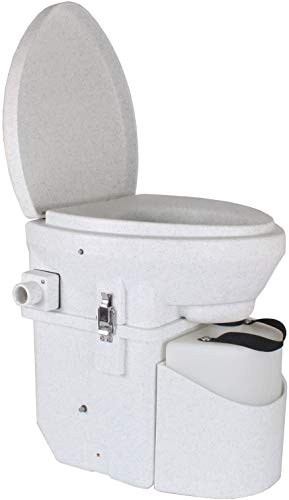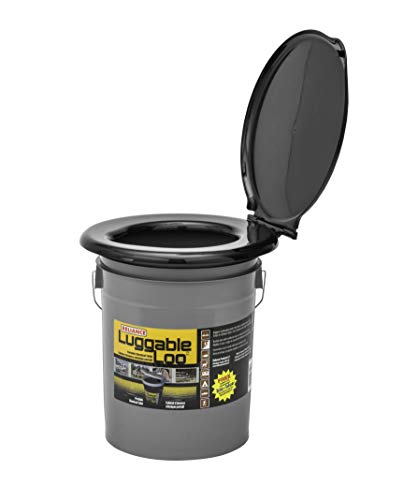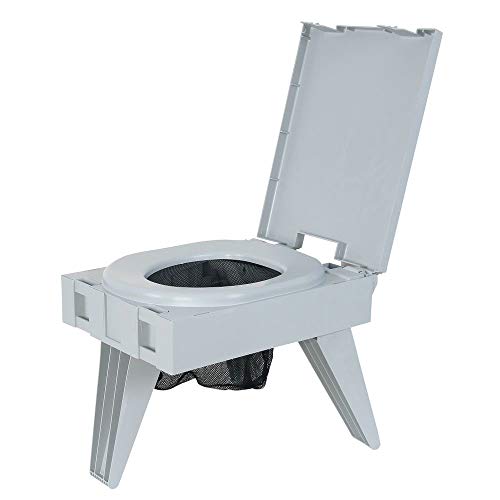How Portable Camping Toilets Work – How to Use Them?
Last Updated on September 12, 2023 by toilethaven
Most camping grounds have restrooms, but often, these facilities are located far away from the camping site. Therefore, the need to have a personal portable camping toilet becomes vital.
Walking for 3-5 minutes in the dead of the night to use a restroom is far from ideal for most people. Porta potties also come in handy when you are road-tripping, fishing, or hunting and have no other form of toilet.
So, how does a portable camping toilet work? To answer these questions, you will need to specify the type of camping toilet you are referring to.
There are 4 main types of portable camping toilets. These are:
- Flushable camping toilets
- Portable composting toilets
- Bucket camping toilets
- Collapsible camping toilets
Let us look at how each of the above porta potties works.
1. How a Flushable Camping Toilet Works

Flushable portable camping toilets are the most sophisticated camping toilets. They are designed to function and feel similar to residential flush toilets.
These toilets have three main parts: the bowl, the fresh water tank, and the waste water tank, also known as a holding tank. The holding tank is located at the bottom to enable the waste to flow from the bowl downwards through gravity.
Their bowls come with a seat and lid. Some of the best flushable porta potties have an elongated toilet bowl and seat, which are more comfortable than round ones.
They also try to make sure that the seat height is as close as possible to that of a standard toilet so you don’t have to bend your knees too much. These toilet’s seat lid normally snaps on the bowl to minimize vibrations during transportation.
There is a sliding valve that separates the bowl and the holding tank. This valve serves two functions. The first is to prevent the waste from leaking/spilling, and the second is to contain unpleasant gases inside the holding tank.
Prior to using the toilet, a little chemical (blue in color) is added to the holding tank. This helps break down the waste into a slurry and also removes bad odors.
The freshwater tank is normally smaller than the holding tank. It, however, has a removable cup at the top that allows you to add more water when the level in the tank goes down.
To use the toilet, look for the sliding valve handle, which is mostly located at the front of the toilet. Pull it out to expose the holding tank to the bowl. Sit on the toilet and proceed to do your business.
Most of these toilets use a manual pump mounted at the top of the freshwater tank for flushing. You will need to pump it a few times in order to flush. An exception to this is the Thetford Porta Potti, which uses a battery-powered flushing system.
The best flushable camping toilets have a level indicator to show you the level of waste in the holding tank. This helps you to accurately know when to dump the waste.
Most flushable porta potties have a detachable holding tank normally connected to the rest of the toilet using side latches. Disconnecting the holding tank for dumping takes under a minute.
Flushable camping toilet holding tanks are easy to carry and can be emptied in any flush toilet. A pour-out spout at the top of the tank allows you to safely dump the waste without it splashing back at you. Decent toilets have a pivoting spout.
As soon as all the waste has been poured out, rinse the holding tank with clean water 2 or 3 times. Attach it back to the rest of the toilet.
If you would like to see a few of the best Flushable portable camping toilets, check out this post I wrote a while ago.
2. How a Portable Composting Toilet Works

A composting toilet is a dry/non-flush toilet that biologically breaks down human waste into dry compost matter that can be later used as a garden fertilizer. Some composting toilets are installed permanently like regular toilets, but the best ones for camping are lightweight and easily portable.
They have three main parts. The first one is the bowl at the top of the toilet, a liquids/urine bin at the front, and a solids bin directly under the bowl.
Composting toilets are designed in such a way that liquid waste (urine) is separated from solid waste. For effective decomposition to happen, the solid matter needs to have as little moisture as possible.
Urine is also responsible for most of the bad odors; hence, separating it from the solid waste eliminates the potential for an awful-smelling toilet. You should empty the urine bin every day, preferably in the morning.
Some composting toilets may look slightly different from what I have described, but that is how the main parts are organized. Cheap composting toilets do not have a means of separating liquid waste from solid waste and tend to smell a lot.
The solids bin can be used for a long time before the need to empty it. The waste also needs time for decomposition to happen; this is another reason you need to ensure urine does not go inside the solids bin.
Before using a composting toilet, you should first add a carbon-based substance inside the solids bin. These are substances like peat moss, sawdust, and coconut coir. They help create air pockets inside the bin, speeding up decomposition and preventing bad odors.
Composting toilets have an agitator on the side that helps you mix the waste and the peat moss after every use. A valve at the bottom of the bowl keeps the bin air-tight unless it is being used.
To prevent leaving streaks of waste on the bowl, you should have a water spray bottle on the side. Wet the bowl with a little water, then proceed to use the toilet.
You should also have a brush to clean the bowl in case some waste embeds on the bowl. Use the spray bottle and brush to clean the bowl. This way, you will avoid using too much water, which would affect the overall efficiency of the toilet.
Most decent composting toilets will also have a fan, which can run on both AC and DC, to further prevent bad odors from accumulating in the bin. Apart from just removing the awful smell, the fan keeps the bin’s contents dry to speed up the decomposition process.
A while ago, I wrote a detailed article reviewing the best composting toilets in the market. Check it out here.
3. How Bucket Portable Camping Toilets Work

Bucket portable camping toilets, as their name implies, are simple 5-gallon bucket toilets with a snap lid that is used as a seat. They are the simplest and least expensive camping toilets.
You can either make your own bucket toilet or buy an already-made one. Just like ordinary buckets, they come with a metal handle to help you easily carry them around.
To use a bucket toilet, you will need to have compostable garbage bags and poo powder. You can also buy bags with a gel at the bottom that helps to break down the waste and prevent bad odors.
Ordinary garbage bags and kitty litter work just fine if you don’t want to buy any of those products. You should, however, double on the garbage bags to prevent any leakage.
To make sure that you don’t come into contact with the waste at any time, make sure that the garbage bags go under the toilet seat and not over. Therefore, you should remove the seat, put the bag, make sure that its edges hang outside the rim of the bucket, and then put the seat and lid back.
By so doing, you will only need to grab the edges of the garbage bags during dumping, eliminating any chances of touching human waste.
I like the fact that the seat lids are designed in such a way that they snap tightly on the rim of the bucket. The waste is, therefore, restricted within the buckets and will not fly off even during transportation.
The main advantages of bucket portable camping toilets are that they are inexpensive and do not need any water to function. Another thing is they are extremely lightweight, which makes them easy to carry around.
Since bucket toilets cannot separate liquid waste from solid waste, they will need to be emptied frequently lest they start smelling. The seat opening is also smaller than most people would like. These are 2 of the main disadvantages of bucket camping toilets.
If you would like to check out some of the best bucket portable toilets in the market, check out this post I wrote some time back.
4. How Collapsible Portable Camping Toilets Work

A collapsible portable camping toilet is a toilet with collapsible or foldable legs. They are very compact and easily fit in a tight spot, which is helpful, especially during transportation.
Just like bucket toilets, collapsible camping toilets are also dry toilets. They are, therefore, a great option if you are camping deep in the forest or high in the mountains where running water does not exist.
The only difference between bucket toilets and collapsible portable toilets is that collapsible porta-potties look more stylish and can also fit in tight spots. Other than that, both of these toilets work in pretty much the same way.
To use a collapsible toilet, unfold its legs fully. Most of them have three legs. It is important to make sure that each leg has fully extended out to avoid breaking them or even falling off. Often, a leg will let out a click sound as confirmation that it is fully extended.
Once that is done, insert a garbage bag inside the bowl and add some poo powder. Go ahead and do your business. Whenever possible, especially for gentlemen, do the number 1 outside (if it is not prohibited) and reserve the toilet for the number 2.
The one thing I like the most about collapsible camping toilets is that they are sturdy. You will notice that the legs spread outwards, increasing the overall stability of the toilet. You are, therefore, not likely to fall off from these toilets.
Most collapsible toilets are, however, very short compared to regular home toilets. You will, therefore, need to squat way too much that you may find comfortable. They are, therefore, ideal for people with bad knees.
To see 5 of the best collapsible portable camping toilets in the market, check out this post.
Final Words
Portable camping toilets are easy to use, inexpensive, and a must-have when camping in an area without restrooms. They are especially helpful for use during the night when most people would not prefer walking alone outside to the public restroom.
Depending on your needs and preference, you can opt to buy one of the four types of porta potties. Flushable and composting portable toilets are a bit pricier, while collapsible and bucket toilets are easily affordable.
Portable camping toilets can also be used as RV toilets. Most of them come with a hold-down kit (sold separately) to fix them on the RV floor.
Having a portable toilet in your home can also be very useful, especially for emergencies. Sometimes, you have no running water in your pipes, or you could be remodeling your bathroom, and a porta potty would, therefore, come in handy.
FAQs
1. Can you poop in a portable toilet?
Yes, you can, and you should. If you can’t poop in it, then it is hardly a toilet. Portable toilets are designed to help you do the number 1 and the number 2.
If it is a flushable portable toilet, you will have to dump the waste after the holding tank is full, but if it is a dry portable toilet, you will need to dispose of the waste at an appropriate dumping area.
2. How do you empty a portable toilet?
A portable toilet’s holding tank is connected to the bowl and fresh water tank using side latches. Unlatch the holding tank and empty its contents in a flush toilet.
You will see a pour-out spout with a cap at the top of the holding tank. Remove the cap and rotate the spout to face away from yourself. Aim inside the toilet bowl and proceed to dump.
To empty a dry portable/bucket toilet, fold the garbage bag and dump the waste at an appropriate garbage disposal point. Do not just throw waste anywhere. That is environmental pollution, and the waste could also spread waterborne diseases.
3. How often do you need to empty a portable toilet?
Most portable toilets have a level indicator showing the waste level in the holding tank. You are then able to know precisely when to empty it. Bucket portable toilets should be emptied as often as possible, preferably daily.
4. Can you put toilet paper in a portable toilet?
Yes, you can, but you should only use a small amount of it, and only use one which will break down easily. Choose toilet paper that is specially designed for RV toilets or septic systems since they disintegrate faster without clogging up the holding tank.
5. What chemicals do you put in a portable toilet?
The chemicals added to portable toilets are dyes, biocides, surfactants, and fragrances. The dye (normally blue) helps to conceal the waste, while the biocides inhibit the growth of bacteria in the holding tank.
Surfactants/detergents lower the surface tension between the waste and the chemical liquid, increasing the effectiveness of the biocides, while the fragrances are responsible for odor elimination.
6. How do I stop my portable toilet from smelling?
Dropping a cleaning tablet inside the holding tank monthly will help reduce the foul odor. Letting out air from the holding tank will also help. Pull out the sliding valve and place the porta-potty in an area with a natural airflow to expel the unpleasant gases.
This is how regular toilets are vented. Choose a time when the toilet is less likely to be used and give it a few minutes/hours to “breathe.”
7. Why do portable toilets stink?
This is because portable toilets do not have a vent, unlike regular toilets; hence, sewage gases accumulate inside. Observing proper hygiene and regularly opening the holding tank valve for a few minutes to expel the trapped gasses can help reduce the awful smells.